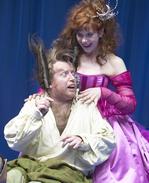SITE GUIDE
SEARCH
REVIEWS
REVIEW ARCHIVES
ADVERTISING AT CURTAINUP
FEATURES
NEWS
Etcetera and
Short Term Listings
LISTINGS
Broadway
Off-Broadway
NYC Restaurants
BOOKS and CDs
OTHER PLACES
Berkshires
London
California
New Jersey
DC
Philadelphia
Elsewhere
QUOTES
TKTS
PLAYWRIGHTS' ALBUMS
LETTERS TO EDITOR
FILM
LINKS
MISCELLANEOUS
Free Updates
Masthead
Writing for Us
A CurtainUp  London Review
London Review
 London Review
London ReviewA Midsummer Night’s Dream
|
Reason and Love keep little company together nowadays— Bottom
|

Paul Hunter as Bottom and Siobhan Redmond as Titania
(Photo: Manuel Harlan) |
Mike Britton’s design boldly transforms the Globe into a solemn Athens, quickly overturned into an anarchic, raucous, colour fest for the forest. The black cloths covering the theatre’s painted columns and backdrop are replaced by a bright blue drape and punk-style fairies plant fuchsia flowers in the stage. Whilst the Athenian court was dressed in black puritanical costume, the fairies appear in richly-coloured, torn period-costumes (including tutus for the men) and smudged make-up. Meanwhile, a large silver balloon anchored to the Globe’s roof bobs in the wind and in and out of the audience’s consciousness. As the evening grows darker, the moon becomes a more magical symbol of the scene’s enchantment.
The lovers, one of the most difficult components to execute successfully, are played with delightful abandon, all-encompassing self-involvement and physically-expressed bickering. Well-orchestrated, their quarrels are full of clever symmetries and overstated movement. The lovers may border on the self-parodic, but their exaggerated emotions reflect the highly-coloured background. Whilst their scenes of prolonged jealousies, exchanged and unrequited loves, are often tedious when played in earnest, the lively portrayals in this production never bore.
Moreover, the comic strength of the lovers’ scene does not impinge upon the Mechanicals’ clowning, as so often happens in productions of A Midsummer Night’s Dream. This is largely due to Michael Matus’ excellent Peter Quince, overseeing his band of amateur actors with genial authority. Bottom (played by the accomplished comic actor Paul Hunter) hangs upon Quince’s words with all the enthusiasm of a hungry dog awaiting some Pedigree Chum. In keeping with the amplified tone of the rest of the production, all innuendoes are fully and absolutely exploited, whilst Bottom and Flute (Peter Bankolé) actually enjoy their homosexual love affair as Pyramus and Thisbe.
The fairies, on the other hand, are played with suitably riotous flair, whilst Puck (Michael Jibson) is unusually unathletic: a refreshing, if knowing, antidote to the trapeze-artist Pucks we often see. Their perfect indifference to humans’ welfare is nicely revealed when he extracts the mortal lovers’ eyes in order to anoint them with the flower’s love potion. The rulers, on the other hand, lack zest in parts and supremacy in others. Undermining the play’s structural framework somewhat, Siobhan Redmond’s Titania is frivolously girlish and Tom Mannion’s Oberon is overall lacklustre, in spite of some interesting direction which makes him truly repentant for deceiving his fairy queen.
This high-spirited, intrepid production will not perhaps go down in history as the definitive production of Shakespeare’s comedy, but is nevertheless an enjoyable way to spend a summer evening, with a beguiling design, sumptuous colours and abundance of comedy.
|
A Midsummer Night’s Dream
Written by William Shakespeare Directed by Jonathan Munby With: Peter Bankolé, Jonathan Bond, Oliver Boot, Christopher Brandon, Adam Burton, Richard Clews, Robert Goodale, Paul Hunter, Michael Jibson, Tom Mannion, Michael Matus, Pippa Nixon, Sam Parks, Siobhan Redmond, Laura Rogers, Bethan Walker, Sian Williams Designer: Mike Britton Composer/Music Director: Olly Fox Choreographer: Sian Williams Text work: Giles Block Movement work: Glynn MacDonald Running time: 3 hours and 5 minutes with one interval Box Office: 020 7401 9919 Booking to 4th October 2008 Reviewed by Charlotte Loveridge based on 21st May 2008 performance at Shakespeare’s Globe Theatre, 21 New Globe Walk, London SE1 9DT (Rail/Tube: London Bridge) |
|
REVIEW FEEDBACK Highlight one of the responses below and click "copy" or"CTRL+C"
Paste the highlighted text into the subject line (CTRL+ V): Feel free to add detailed comments in the body of the email. |
|
London Theatre Tickets Lion King Tickets Billy Elliot Tickets Mighty Boosh Tickets Mamma Mia Tickets We Will Rock You Tickets Theatre Tickets |




